Investigation on Chalcogenide Glass Additive Manufacturing for Shaping Mid-infrared Optical Components and Microstructured Optical Fibers
Abstract
1. Introduction
2. Materials and Methods
2.1. Thermal and Physical Optical Properties of the Chosen Glass: Te20As30Se50
2.2. Additive Manufacturing Process
3. Results
3.1. Physical Properties of the Printed Glasses
3.2. Optical Properties of the Printed Glasses
3.3. Optical Components and Fibers Printing
4. Discussion
5. Conclusions
Author Contributions
Funding
Institutional Review Board Statement
Informed Consent Statement
Data Availability Statement
Acknowledgments
Conflicts of Interest
References
- Zakery, A.; Elliott, S.R. Optical properties and applications of chalcogenide glasses: A review. J. Non-Cryst. Solids 2003, 330, 1–12. [Google Scholar] [CrossRef]
- Adam, J.-L.; Calvez, L.; Troles, J.; Nazabal, V. Chalcogenide Glasses for Infrared Photonics. Int. J. Appl. Glass Sci. 2015, 6, 287–294. [Google Scholar] [CrossRef]
- Heo, J.; Rodrigues, M.; Saggese, S.J.; Sigel, G.H. Remote fiber-optic chemical sensing using evanescent-wave interactions in chalcogenide glass fibers. Appl. Opt. 1991, 30, 3944–3951. [Google Scholar] [CrossRef]
- Adam, J.-L.; Zhang, X. Chalcogenide Glasses: Preparation, Properties and Applications; Woodhead Publishing: Cambridge, UK, 2014. [Google Scholar]
- Lavanant, E.; Calvez, L.; Cheviré, F.; Rozé, M.; Hingant, T.; Proux, R.; Guimond, Y.; Zhang, X.-H. Radial gradient refractive index (GRIN) infrared lens based on spatially resolved crystallization of chalcogenide glass. Opt. Mater. Express 2020, 10, 860–867. [Google Scholar] [CrossRef]
- Calvez, L. Chalcogenide glasses and glass-ceramics: Transparent materials in the infrared for dual applications. Comptes Rendus Phys. 2017, 18, 314–322. [Google Scholar] [CrossRef]
- Aggarwal, I.D.; Sanghera, J.S. Development and applications of chalcogenide glass optical fibers at NRL. J. Optoelectron. Adv. Mater. 2002, 4, 665–678. [Google Scholar]
- Lucas, J.; Troles, J.; Zhang, X.H.; Boussard-Pledel, C.; Poulain, M.; Bureau, B. Glasses to see beyond visible. Comptes Rendus Chimie 2018, 21, 916–922. [Google Scholar] [CrossRef]
- Toupin, P.; Brilland, L.; Renversez, G.; Troles, J. All-solid all-chalcogenide microstructured optical fiber. Opt. Express 2013, 21, 14643–14648. [Google Scholar] [CrossRef] [PubMed]
- Gibson, I.; Rosen, D.W.; Stucker, B. Additive Manufacturing Technologies; Springer: Boston, MA, USA, 2014. [Google Scholar] [CrossRef]
- Bandyopadhyay, A.; Bose, S. Additive Manufacturing; CRC Press: Boca Raton, FL, USA, 2019. [Google Scholar]
- Kumar, S.; Czekanski, A. Roadmap to sustainable plastic additive manufacturing. Mater. Today Commun. 2018, 15, 109–113. [Google Scholar] [CrossRef]
- Ngo, T.D.; Kashani, A.; Imbalzano, G.; Nguyen, K.T.Q.; Hui, D. Additive manufacturing (3D printing): A review of materials, methods, applications and challenges. Compos. Part B Eng. 2018, 143, 172–196. [Google Scholar] [CrossRef]
- Murr, L.E.; Gaytan, S.M.; Ramirez, D.A.; Martinez, E.; Hernandez, J.; Amato, K.N.; Shindo, P.W.; Medina, F.R.; Wicker, R.B. Metal Fabrication by Additive Manufacturing Using Laser and Electron Beam Melting Technologies. J. Mater. Sci. Technol. 2012, 28, 1–14. [Google Scholar] [CrossRef]
- Zocca, A.; Colombo, P.; Gomes, C.M.; Günster, J. Additive Manufacturing of Ceramics: Issues, Potentialities, and Opportunities. J. Am. Ceram. Soc. 2015, 98, 1983–2001. [Google Scholar] [CrossRef]
- Marchelli, G.; Prabhakar, R.; Storti, D.; Ganter, M. The guide to glass 3D printing: Developments, methods, diagnostics and results. Rapid Prototyp. J. 2011, 17, 187–194. [Google Scholar] [CrossRef]
- Kotz, F.; Arnold, K.; Bauer, W.; Schild, D.; Keller, N.; Sachsenheimer, K.; Nargang, T.M.; Richter, C.; Helmer, D.; Rapp, B.E. Three-dimensional printing of transparent fused silica glass. Nature 2017, 544, 337–339. [Google Scholar] [CrossRef]
- Chu, Y.; Fu, X.; Luo, Y.; Canning, J.; Tian, Y.; Cook, K.; Zhang, J.; Peng, G.-D. Silica optical fiber drawn from 3D printed preforms. Opt. Lett. 2019, 44, 5358–5361. [Google Scholar] [CrossRef]
- Turner, B.N.; Strong, R.; Gold, S.A. A review of melt extrusion additive manufacturing processes: I. Process design and modeling. Rapid Prototyp. J. 2014, 20, 192. [Google Scholar] [CrossRef]
- Turner, B.N.; Gold, S.A. A review of melt extrusion additive manufacturing processes: II. Materials, dimensional accuracy, and surface roughness. Rapid Prototyp. J. 2015, 21, 250. [Google Scholar] [CrossRef]
- Baudet, E.; Ledemi, Y.; Larochelle, P.; Morency, S.; Messaddeq, Y. 3D-printing of arsenic sulfide chalcogenide glasses. Opt. Mater. Express 2019, 9, 2307–2317. [Google Scholar] [CrossRef]
- Carcreff, J.; Cheviré, F.; Galdo, E.; Lebullenger, R.; Gautier, A.; Adam, J.L.; Coq, D.L.; Brilland, L.; Chahal, R.; Renversez, G.; et al. Mid-infrared hollow core fiber drawn from a 3D printed chalcogenide glass preform. Opt. Mater. Express 2021, 11, 198–209. [Google Scholar] [CrossRef]
- Zaki, R.M.; Strutynski, C.; Kaser, S.; Bernard, D.; Hauss, G.; Faessel, M.; Sabatier, J.; Canioni, L.; Messaddeq, Y.; Danto, S.; et al. Direct 3D-printing of phosphate glass by fused deposition modeling. Mater. Des. 2020, 194, 108957. [Google Scholar] [CrossRef]
- Available online: https://marlinfw.org (accessed on 6 February 2021).
- Shiryaev, V.S.; Adam, J.L.; Zhang, X.H.; Boussard-Pledel, C.; Lucas, J.; Churbanov, M.F. Infrared fibers based on Te-As-Se glass system with low optical losses. J. Non-Cryst. Solids 2004, 336, 113–119. [Google Scholar] [CrossRef]
- Fulcher, G.S. Analysis of recent measurements of the viscosity of glasses. J. Am. Ceram. Soc. 1925, 8, 339–355. [Google Scholar] [CrossRef]
- Yoon, Y.I.; Park, K.; Lee, S.J.; Park, W.H. Fabrication of Microfibrous and Nano-/Microfibrous Scaffolds: Melt and Hybrid Electrospinning and Surface Modification of Poly(L-lactic acid) with Plasticizer. BioMed. Res. Int. 2013, 2013, 309048. [Google Scholar] [CrossRef]
- Gunduz, I.E.; McClain, M.S.; Cattani, P.; Chiu, G.T.C.; Rhoads, J.F.; Son, S.F. 3D printing of extremely viscous materials using ultrasonic vibrations. Addit. Manuf. 2018, 22, 98–103. [Google Scholar] [CrossRef]
- Cheng, C.-C. Refractive index measurement by prism autocollimation. Am. J. Phys. 2014, 82, 214–216. [Google Scholar] [CrossRef]
- Caillaud, C.; Renversez, G.; Brilland, L.; Mechin, D.; Calvez, L.; Adam, J.-L.; Troles, J. Photonic Bandgap Propagation in All-Solid Chalcogenide Microstructured Optical Fibers. Materials 2014, 7, 6120–6129. [Google Scholar] [CrossRef]
- Conseil, C.; Coulombier, Q.; Boussard-Pledel, C.; Troles, J.; Brilland, L.; Renversez, G.; Mechin, D.; Bureau, B.; Adam, J.L.; Lucas, J. Chalcogenide step index and microstructured single mode fibers. J. Non-Cryst. Solids 2011, 357, 2480–2483. [Google Scholar] [CrossRef]
- Meneghetti, M.; Caillaud, C.; Chahal, R.; Galdo, E.; Brilland, L.; Adam, J.-L.; Troles, J. Purification of Ge-As-Se ternary glasses for the development of high quality microstructured optical fibers. J. Non-Cryst. Solids 2019, 503, 84–88. [Google Scholar] [CrossRef]
- Bensaid, S.; Kachenoura, A.; Costet, N.; Bensalah, K.; Tariel, H.; Senhadji, L. Noninvasive detection of bladder cancer using mid-infrared spectra classification. Expert Syst. Appl. 2017, 89, 333–342. [Google Scholar] [CrossRef]
- Le Corvec, M.; Jezequel, C.; Monbet, V.; Fatih, N.; Charpentier, F.; Tariel, H.; Boussard-Pledel, C.; Bureau, B.; Loreal, O.; Sire, O.; et al. Mid-infrared spectroscopy of serum, a promising non-invasive method to assess prognosis in patients with ascites and cirrhosis. PLoS ONE 2017, 12, 15. [Google Scholar] [CrossRef]
- Russell, P. Photonic Crystal Fibers. Science 2003, 299, 358. [Google Scholar] [CrossRef] [PubMed]
- Brilland, L.; Smektala, F.; Renversez, G.; Chartier, T.; Troles, J.; Nguyen, T.N.; Traynor, N.; Monteville, A. Fabrication of complex structures of Holey Fibers in chalcogenide glass. Opt. Express 2006, 14, 1280–1285. [Google Scholar] [CrossRef] [PubMed]
- Gattass, R.R.; Rhonehouse, D.; Gibson, D.; McClain, C.C.; Thapa, R.; Nguyen, V.Q.; Bayya, S.S.; Weiblen, R.J.; Menyuk, C.R.; Shaw, L.B.; et al. Infrared glass-based negative-curvature anti-resonant fibers fabricated through extrusion. Opt. Express 2016, 24, 25697–25703. [Google Scholar] [CrossRef] [PubMed]
- Coulombier, Q.; Brilland, L.; Houizot, P.; Chartier, T.; Nguyen, T.N.; Smektala, F.; Renversez, G.; Monteville, A.; Méchin, D.; Pain, T.; et al. Casting method for producing low-loss chalcogenide microstructured optical fibers. Opt. Express 2010, 18, 9107–9112. [Google Scholar] [CrossRef] [PubMed]
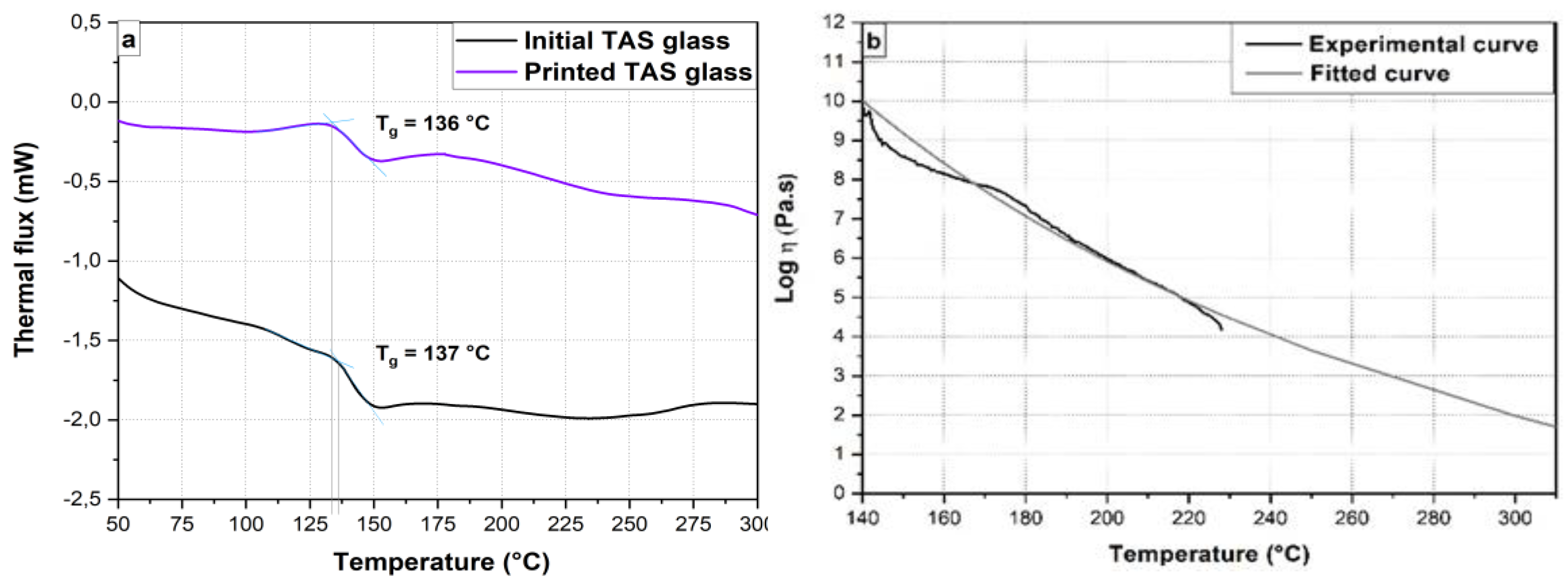
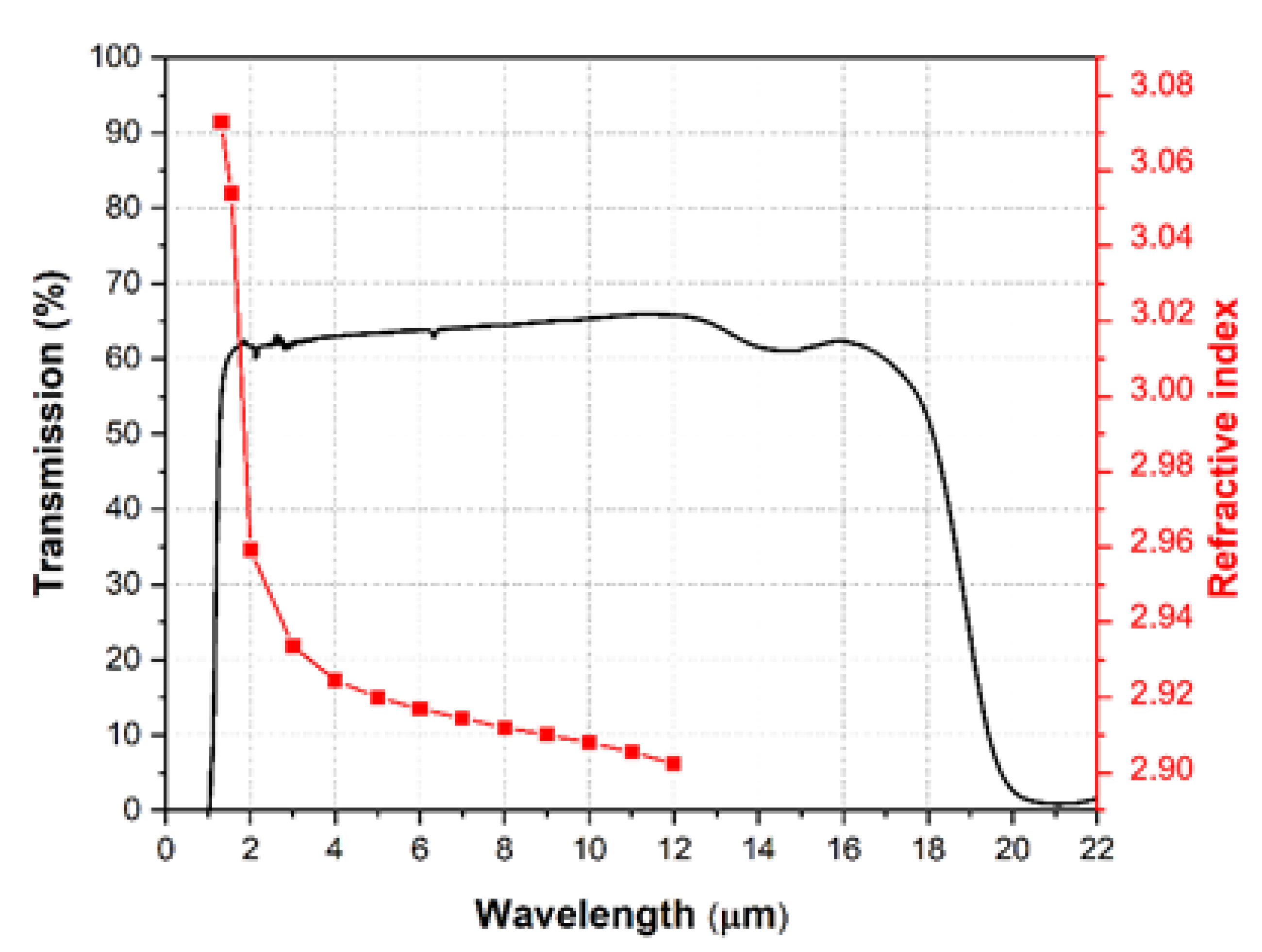

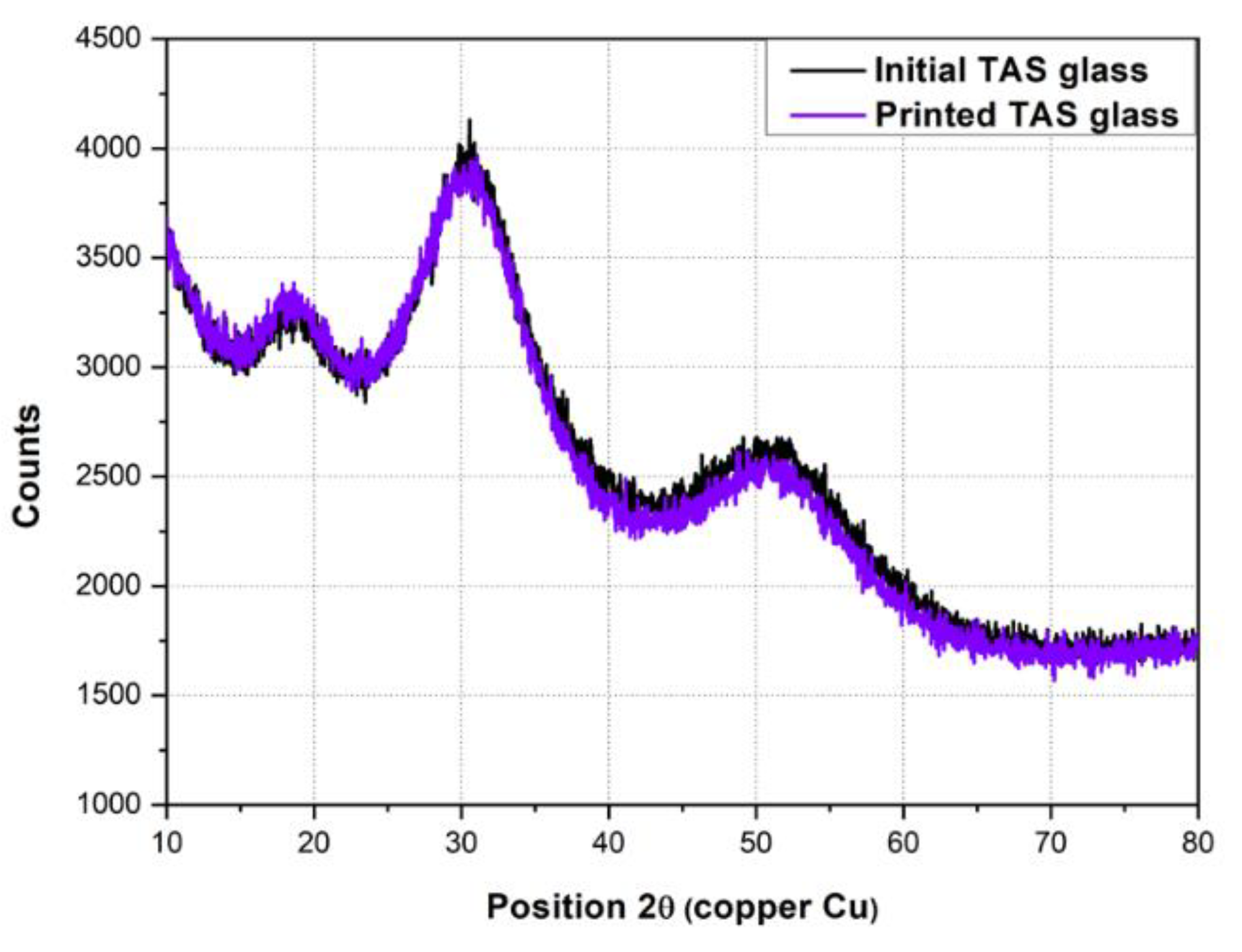

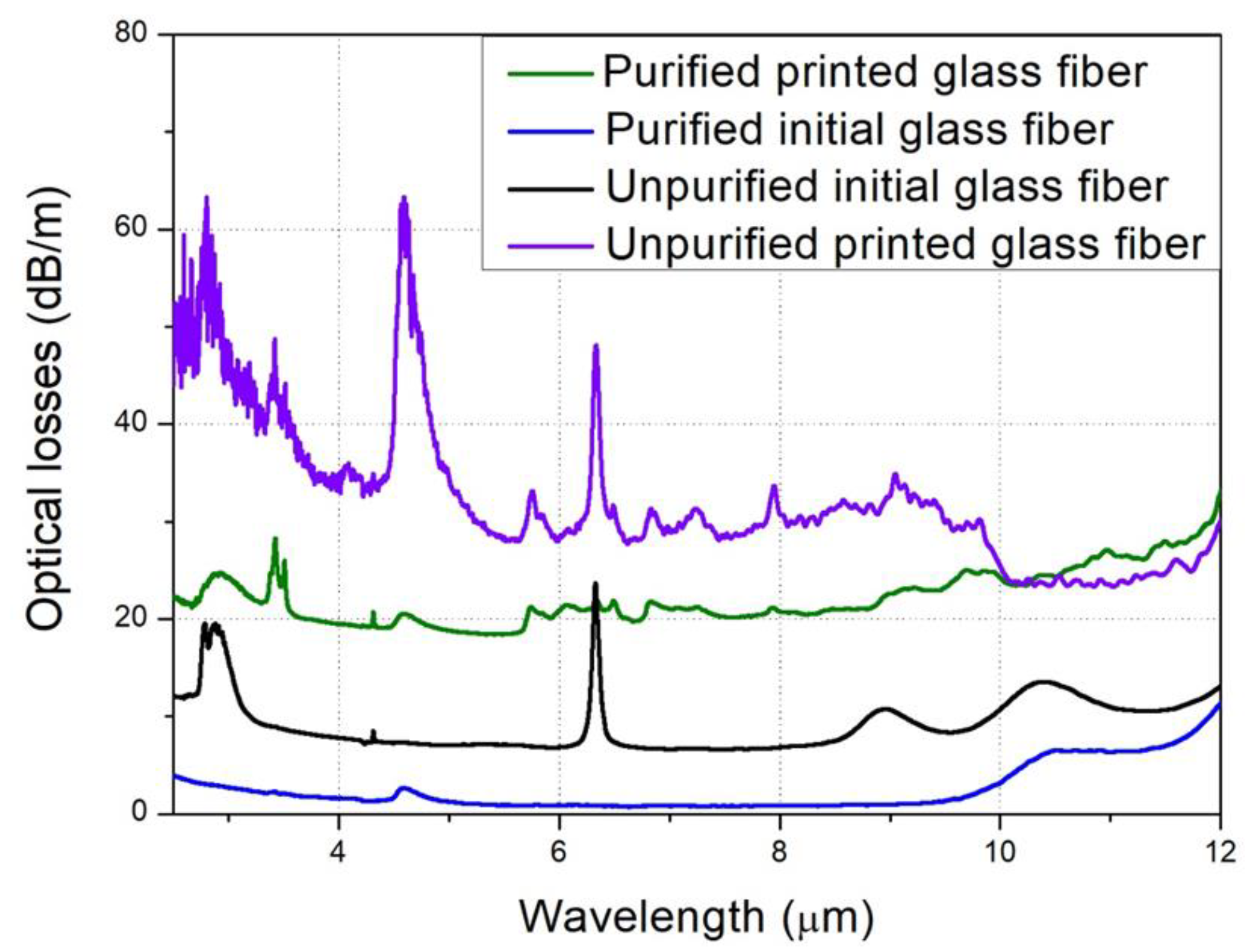
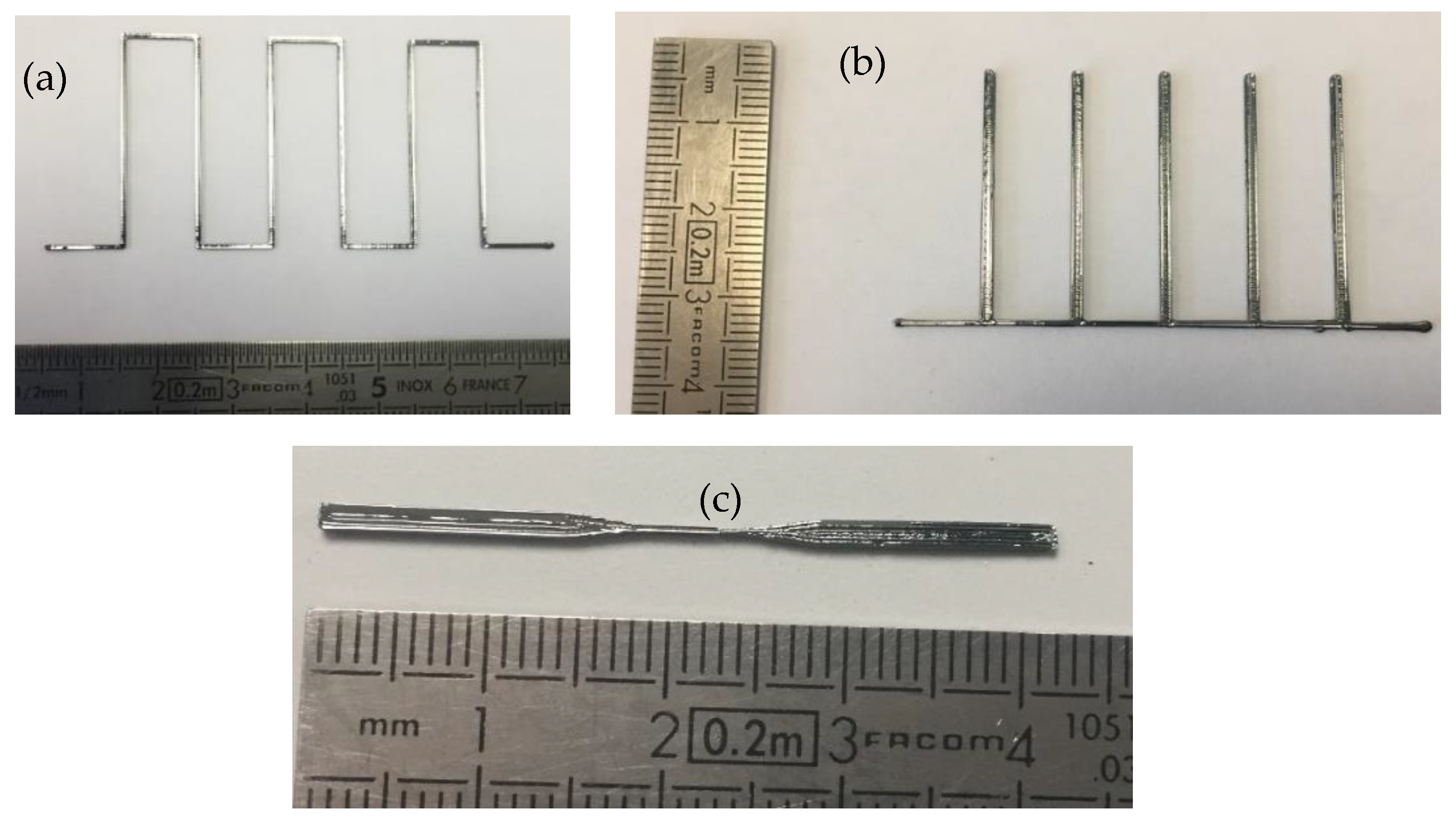

| Initial Glass | Printed Glass | |
|---|---|---|
| Composition from EDS analysis (%) (±1) | Te20As30Se50 | Te21Se29Te50 |
| Bulk transmission range (µm) | 1–18 | 1–18 |
| Fiber transmission range (µm) | 2–12 | 2–12 |
| Tg (°C) (±2) | 137 | 136 |
| Coefficient of thermic expansion (10−6 K−1) (± 1%) | 22.82 | 22.62 |
| Density (g·cm−3) (± 0.02) | 4.86 | 4.81 |
Publisher’s Note: MDPI stays neutral with regard to jurisdictional claims in published maps and institutional affiliations. |
© 2021 by the authors. Licensee MDPI, Basel, Switzerland. This article is an open access article distributed under the terms and conditions of the Creative Commons Attribution (CC BY) license (http://creativecommons.org/licenses/by/4.0/).
Share and Cite
Carcreff, J.; Cheviré, F.; Lebullenger, R.; Gautier, A.; Chahal, R.; Adam, J.L.; Calvez, L.; Brilland, L.; Galdo, E.; Le Coq, D.; et al. Investigation on Chalcogenide Glass Additive Manufacturing for Shaping Mid-infrared Optical Components and Microstructured Optical Fibers. Crystals 2021, 11, 228. https://doi.org/10.3390/cryst11030228
Carcreff J, Cheviré F, Lebullenger R, Gautier A, Chahal R, Adam JL, Calvez L, Brilland L, Galdo E, Le Coq D, et al. Investigation on Chalcogenide Glass Additive Manufacturing for Shaping Mid-infrared Optical Components and Microstructured Optical Fibers. Crystals. 2021; 11(3):228. https://doi.org/10.3390/cryst11030228
Chicago/Turabian StyleCarcreff, Julie, François Cheviré, Ronan Lebullenger, Antoine Gautier, Radwan Chahal, Jean Luc Adam, Laurent Calvez, Laurent Brilland, Elodie Galdo, David Le Coq, and et al. 2021. "Investigation on Chalcogenide Glass Additive Manufacturing for Shaping Mid-infrared Optical Components and Microstructured Optical Fibers" Crystals 11, no. 3: 228. https://doi.org/10.3390/cryst11030228
APA StyleCarcreff, J., Cheviré, F., Lebullenger, R., Gautier, A., Chahal, R., Adam, J. L., Calvez, L., Brilland, L., Galdo, E., Le Coq, D., Renversez, G., & Troles, J. (2021). Investigation on Chalcogenide Glass Additive Manufacturing for Shaping Mid-infrared Optical Components and Microstructured Optical Fibers. Crystals, 11(3), 228. https://doi.org/10.3390/cryst11030228






